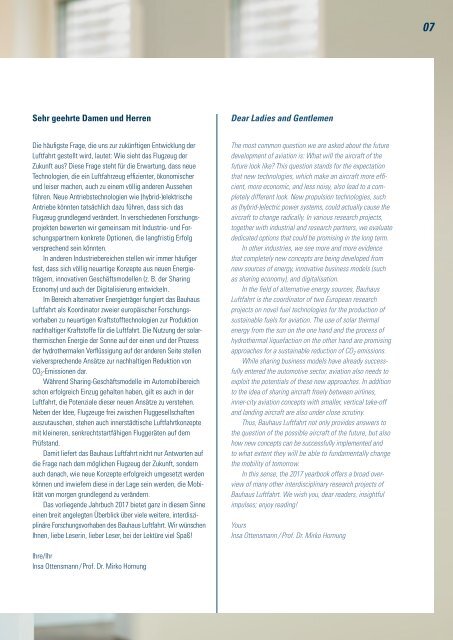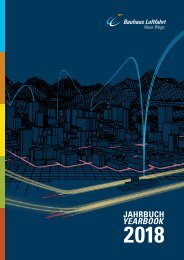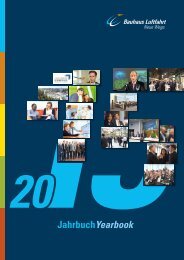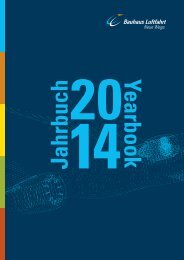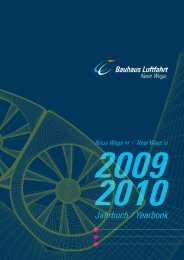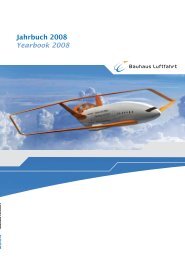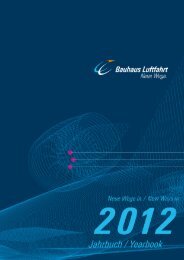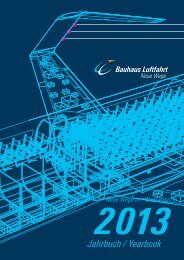Sie wollen auch ein ePaper? Erhöhen Sie die Reichweite Ihrer Titel.
YUMPU macht aus Druck-PDFs automatisch weboptimierte ePaper, die Google liebt.
07<br />
Sehr geehrte Damen und Herren<br />
Dear Ladies and Gentlemen<br />
Die häufigste Frage, die uns zur zukünftigen Entwicklung der<br />
<strong>Luftfahrt</strong> gestellt wird, lautet: Wie sieht das Flugzeug der<br />
Zukunft aus? Diese Frage steht für die Erwartung, dass neue<br />
Technologien, die ein Luftfahrzeug effizienter, ökonomischer<br />
und leiser machen, auch zu einem völlig anderen Aussehen<br />
führen. Neue Antriebstechnologien wie (hybrid-)elektrische<br />
Antriebe könnten tatsächlich dazu führen, dass sich das<br />
Flugzeug grundlegend verändert. In verschiedenen Forschungsprojekten<br />
bewerten wir gemeinsam mit Industrie- und Forschungspartnern<br />
konkrete Optionen, die langfristig Erfolg<br />
versprechend sein könnten.<br />
In anderen Industriebereichen stellen wir immer häufiger<br />
fest, dass sich völlig neuartige Konzepte aus neuen Energieträgern,<br />
innovativen Geschäftsmodellen (z. B. der Sharing<br />
Economy) und auch der Digitalisierung entwickeln.<br />
Im Bereich alternativer Energieträger fungiert das <strong>Bauhaus</strong><br />
<strong>Luftfahrt</strong> als Koordinator zweier europäischer Forschungsvorhaben<br />
zu neuartigen Kraftstofftechnologien zur Produktion<br />
nachhaltiger Kraftstoffe für die <strong>Luftfahrt</strong>. Die Nutzung der solarthermischen<br />
Energie der Sonne auf der einen und der Prozess<br />
der hydrothermalen Verflüssigung auf der anderen Seite stellen<br />
vielversprechende Ansätze zur nachhaltigen Reduktion von<br />
CO 2 -Emissionen dar.<br />
Während Sharing-Geschäftsmodelle im Automobilbereich<br />
schon erfolgreich Einzug gehalten haben, gilt es auch in der<br />
<strong>Luftfahrt</strong>, die Potenziale dieser neuen Ansätze zu verstehen.<br />
Neben der Idee, Flugzeuge frei zwischen Fluggesellschaften<br />
auszutauschen, stehen auch innerstädtische <strong>Luftfahrt</strong>konzepte<br />
mit kleineren, senkrechtstartfähigen Fluggeräten auf dem<br />
Prüfstand.<br />
Damit liefert das <strong>Bauhaus</strong> <strong>Luftfahrt</strong> nicht nur Antworten auf<br />
die Frage nach dem möglichen Flugzeug der Zukunft, sondern<br />
auch danach, wie neue Konzepte erfolgreich umgesetzt werden<br />
können und inwiefern diese in der Lage sein werden, die Mobilität<br />
von morgen grundlegend zu verändern.<br />
Das vorliegende <strong>Jahrbuch</strong> <strong>2017</strong> bietet ganz in diesem Sinne<br />
einen breit angelegten Überblick über viele weitere, interdisziplinäre<br />
Forschungsvorhaben des <strong>Bauhaus</strong> <strong>Luftfahrt</strong>. Wir wünschen<br />
Ihnen, liebe Leserin, lieber Leser, bei der Lektüre viel Spaß!<br />
The most common question we are asked about the future<br />
development of aviation is: What will the aircraft of the<br />
future look like? This question stands for the expectation<br />
that new technologies, which make an aircraft more efficient,<br />
more economic, and less noisy, also lead to a completely<br />
different look. New propulsion technologies, such<br />
as (hybrid-)electric power systems, could actually cause the<br />
aircraft to change radically. In various research projects,<br />
together with industrial and research partners, we evaluate<br />
dedicated options that could be promising in the long term.<br />
In other industries, we see more and more evidence<br />
that completely new concepts are being developed from<br />
new sources of energy, innovative business models (such<br />
as sharing economy), and digitalisation.<br />
In the field of alternative energy sources, <strong>Bauhaus</strong><br />
<strong>Luftfahrt</strong> is the coordinator of two European research<br />
projects on novel fuel technologies for the production of<br />
sustainable fuels for aviation. The use of solar thermal<br />
energy from the sun on the one hand and the process of<br />
hydrothermal liquefaction on the other hand are promising<br />
approaches for a sustainable reduction of CO 2 emissions.<br />
While sharing business models have already successfully<br />
entered the automotive sector, aviation also needs to<br />
exploit the potentials of these new approaches. In addition<br />
to the idea of sharing aircraft freely between airlines,<br />
inner-city aviation concepts with smaller, vertical take-off<br />
and landing aircraft are also under close scrutiny.<br />
Thus, <strong>Bauhaus</strong> <strong>Luftfahrt</strong> not only provides answers to<br />
the question of the possible aircraft of the future, but also<br />
how new concepts can be successfully implemented and<br />
to what extent they will be able to fundamentally change<br />
the mobility of tomorrow.<br />
In this sense, the <strong>2017</strong> yearbook offers a broad overview<br />
of many other interdisciplinary research projects of<br />
<strong>Bauhaus</strong> <strong>Luftfahrt</strong>. We wish you, dear readers, insightful<br />
impulses; enjoy reading!<br />
Yours<br />
Insa Ottensmann / Prof. Dr. Mirko Hornung<br />
Ihre/Ihr<br />
Insa Ottensmann / Prof. Dr. Mirko Hornung


